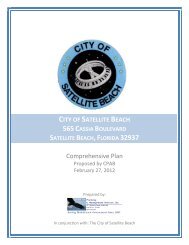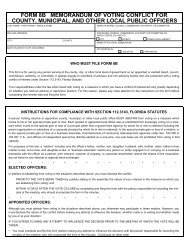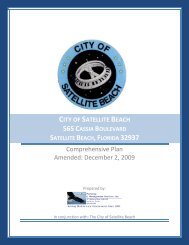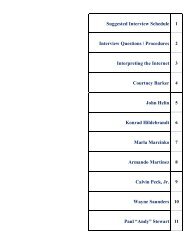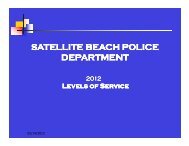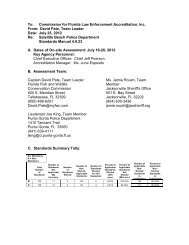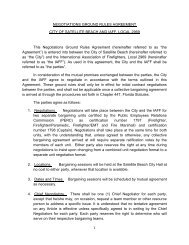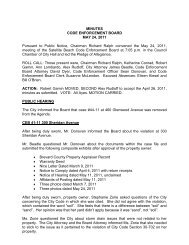Supporting Documents (Data and Analysis) - Satellite Beach
Supporting Documents (Data and Analysis) - Satellite Beach
Supporting Documents (Data and Analysis) - Satellite Beach
Create successful ePaper yourself
Turn your PDF publications into a flip-book with our unique Google optimized e-Paper software.
also employs an innovative treatment process that makes possible very rapid adjustments to changing<br />
source water conditions. The new treatment process also allows Melbourne to meet evolving state<br />
<strong>and</strong> federal regulations.<br />
A chemical coagulant is added to the raw water as it enters a coagulation tank. The coagulant<br />
destabilizes the suspended solids <strong>and</strong> with proper mixing early stage floc formation begins. The<br />
coagulated water then flows over a weir into the injection tank where polymer <strong>and</strong> micros <strong>and</strong> are<br />
added to further enhance floc formation. Next, the water passes through the underflow passage into<br />
the maturation tank where the majority of ballasted floc formation occurs. After the water leaves the<br />
maturation tank, it enters the settling tank where the floc rapidly settles <strong>and</strong> is removed from the<br />
treated water via lamellar settling. Clarified water exits the system via a series of collection troughs<br />
or weirs for subsequent filtration, disinfection <strong>and</strong> delivery to the distribution network.<br />
Located nearby is the Joe Mullins Reverse Osmosis Water Treatment Plant, which utilizes well water<br />
<strong>and</strong> can produce up to 6.5 million gallons of water per day. The average daily dem<strong>and</strong> on the<br />
drinking water system is 15.2 million gallons as water is distributed to Melbourne <strong>and</strong> most<br />
surrounding communities. This R/O Water Treatment Plant was put into operation in 1995 with a 6.5<br />
MGD capacity <strong>and</strong> a 4.0 million gallon ground water storage tank. The R/O WTP's raw water supply<br />
is obtained from three Floridan Aquifer wells at close to 850 feet underground. Each yields<br />
approximately 3.1 million gallons per day.<br />
The permitted peak capacity of the surface WTP is 20.0 MGD. The capacity of the R/O plant is 6.5<br />
MGD when 1.5 MGD of raw well water is blended with R/O product water. As a result, the total<br />
drinking water capacity now available is 26.5 MGD. Currently, the average daily dem<strong>and</strong> of 15.2 is<br />
being met through the production <strong>and</strong> blending of 11.4 MGD of water from the surface WTP <strong>and</strong> 3.8<br />
MGD of water from the R/O WTP.<br />
The City of Melbourne continually strives to improve their water treatment processes <strong>and</strong> protect<br />
their water resources. Construction of Phase II of the John A. Buckley Surface Water Treatment<br />
Plant expansion <strong>and</strong> improvement project is underway. This $15 million project will provide for<br />
ozonation, which is an advanced system used for disinfections, as well as taste <strong>and</strong> odor control.<br />
Ozonation will replace choramination as the primary means of disinfections for the City’s drinking<br />
water system.<br />
Melbourne’s water supply is derived from two independent sources, Lake Washington <strong>and</strong> the<br />
Floridan Aquifer. Lake Washington is part of the St. Johns River, the largest river in Florida. Lake<br />
Washington is approximately four miles long, <strong>and</strong> mile wide, <strong>and</strong> 10 to 15 feet deep. Lake<br />
Washington is one of the few surface water supplies used for drinking water in Florida. The Floridan<br />
Aquifer is an extensive underground water source that covers some 82,000 square miles.<br />
Melbourne’s reverse osmosis water treatment plant is supplied by three Floridan Aquifer system<br />
wells. The wells are approximately 650 to 900 feet deep. Brackish water from the Floridan Aquifer is<br />
treated with a reverse osmosis filtering process to remove salts <strong>and</strong> impurities. The water from Lake<br />
Washington, which is treated through the Actiflo process <strong>and</strong> then filtered, is blended with treated<br />
reverse osmosis water. Chloramine booster stations in the water distribution system ensure that<br />
adequate levels of disinfectant are maintained throughout the system. Melbourne now has a peak<br />
Infrastructure Element<br />
<strong>Data</strong> <strong>and</strong> <strong>Analysis</strong> 4-9



